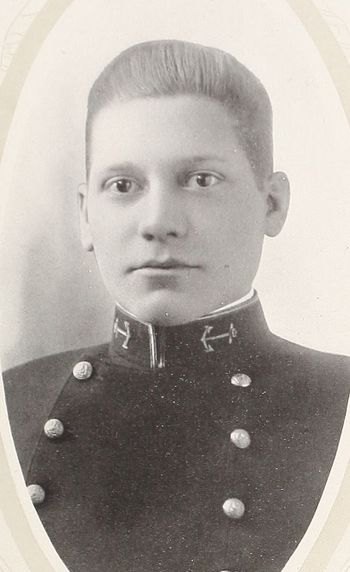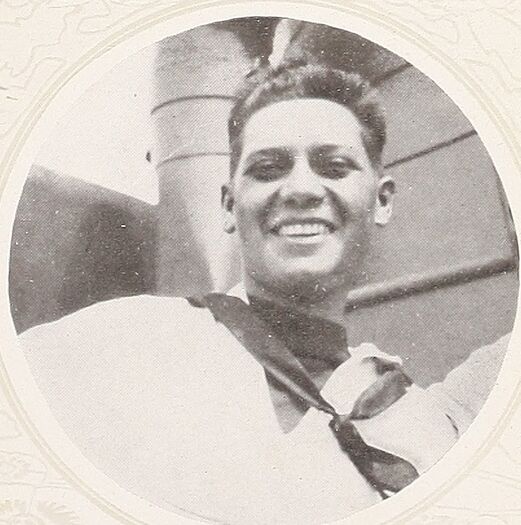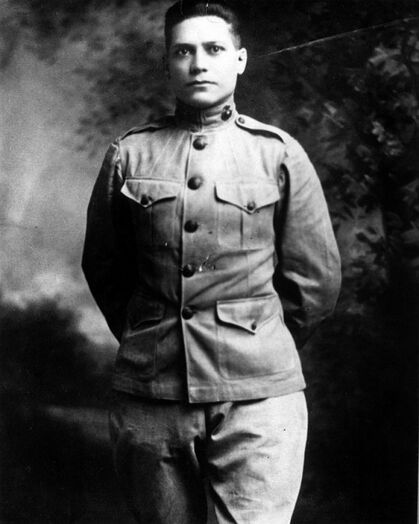JOHN A. MINNIS, CAPT, USMC
John Minnis '15
Lucky Bag
From the 1915 Lucky Bag:
John Andrew Minnis
Montgomery, Alabama
"Scotty" "John" "Scotchman"
HEP. heads up, chins in, throw your shoulders back, when one of Alabama's most favored sons is among you. This is our old friend, the "Scotchman." John is a military man; his brace has been a model for underclassmen for three years, and he might tell them to brace as he does and save wind describing the regulation carriage demanded by the Reg Book. As an athlete, Minnis has taken a prominent part in the class battles. He plays good baseball, still better basketball, but he shines brightest as captain of our class football team; also, for this typical Southerner boxing has many charms, which are generally gained at the expense of his opponents.
Scotty is a consistent fusser, with attentions centered rather conspicuously in the Bay State and on the Gulf border. "Say, she was so-ome queen, wasn't she, boy?" Scotty is not a hard guy: he's a hard worker and he likes to see everyone about him work. As adjutant he was the best we've seen. "I love to watch him read those orders!" Minnis is savvy, and he says things in the section room in such a manner that the prof, says they are right, whether they are or not. He is generally right.
The Scotchman is a great man to make a liberty with. Miss Gish is ever ready to testify to this fact, while Quynn admits that he was a potent factor in preserving peace in London when there was no more steak. In fact, John is always happy to help a friend, and everybody is his friend. Minnis has high ideals; he is the type of shipmate that makes a cruise worth while; every inch of him is man.
"Let's have another soda."
Football Numerals; Basketball Numerals; Baseball Numerals.

John Andrew Minnis
Montgomery, Alabama
"Scotty" "John" "Scotchman"
HEP. heads up, chins in, throw your shoulders back, when one of Alabama's most favored sons is among you. This is our old friend, the "Scotchman." John is a military man; his brace has been a model for underclassmen for three years, and he might tell them to brace as he does and save wind describing the regulation carriage demanded by the Reg Book. As an athlete, Minnis has taken a prominent part in the class battles. He plays good baseball, still better basketball, but he shines brightest as captain of our class football team; also, for this typical Southerner boxing has many charms, which are generally gained at the expense of his opponents.
Scotty is a consistent fusser, with attentions centered rather conspicuously in the Bay State and on the Gulf border. "Say, she was so-ome queen, wasn't she, boy?" Scotty is not a hard guy: he's a hard worker and he likes to see everyone about him work. As adjutant he was the best we've seen. "I love to watch him read those orders!" Minnis is savvy, and he says things in the section room in such a manner that the prof, says they are right, whether they are or not. He is generally right.
The Scotchman is a great man to make a liberty with. Miss Gish is ever ready to testify to this fact, while Quynn admits that he was a potent factor in preserving peace in London when there was no more steak. In fact, John is always happy to help a friend, and everybody is his friend. Minnis has high ideals; he is the type of shipmate that makes a cruise worth while; every inch of him is man.
"Let's have another soda."
Football Numerals; Basketball Numerals; Baseball Numerals.
Biography
From Find A Grave:
John Andrew Minnis was born the son of Joseph Henry and Maggie Stokes Minnis in Alabama on June 6, 1891.
He was educated at Starke's School (later known as Starke University School), graduating in 1911. He also assisted then Professor John Metcalfe Starke in teaching at the school before entering the U.S. Naval Academy later that year. He was appointed by Senator J.H. Bankhead.
At the academy, he was known as "John", "Scotty", and "Scotchman." John Minnis was a great athlete, involved in baseball, basketball and football. He graduated as part of the class of 1915 and was commissioned as an officer in the Marine Corps.
On January 5, 1916, Lt John Minnis and Miss Laura Winkler were married by the Rev. E.E. Cobbs at St Thomas Episcopal Church in Greenville, Alabama. One of their gifts was described as a "handsome silver tea service on a mahogany tray, mounted in silver with the naval insignia in the center." The tea service was the gift of the U.S. Naval Class of 1915.
They were blessed on October 18, 1916, with the birth of their first child and daughter, Laura Winkler Minnis.
Lt Minnis was in several battles at Santo Domingo, Dominican Republic. He also took part in several major engagements in France during World War I. Late in 1918, he was wounded. Lt. John Minnis was awarded the Distinguished Service Cross and the Navy Cross for gallantry.
According to Find a Grave member Charles McDowell, Captain Minnis was attached to the 38th Infantry Regiment (3rd Division) and was awarded the Distinguished Service Cross for extraordinary heroism in action on July 15, 1918, near Mezy, France (see War Department General Orders No. 22 dated April 8, 1920). He was also awarded the Navy Cross for the same action.
After the war ended, Captain Minnis transferred to the Aviation section of the Marine Corps and was stationed at Quantico Marine Corps Base, Quantico, Virginia. He developed a great reputation for flying.
On the night of September 23, 1921, Captain Minnis was participating in maneuvers, attempting to escape from the beams of large searchlights which were sweeping the skies. When he was last seen, Captain Minnis executed a nose dive to evade the lights. The water around the area of Quantico Creek and the Potomac River was about twelve feet and it was several hours before it was realized that Captain Minnis' aircraft had crashed, and his body recovered.
Survivors included his widow, Mrs. Laura Winkler Minnis; his daughter, also Laura Winkler Minnis; his parents, Mr. and Mrs. J.H. Minnis of Montgomery, Alabama; and two sisters, Mrs. Lucile Dudley Dawson of Montgomery; and Mrs. Ruth Boyd Bateman of Norwalk, Ohio.
Services were held at Quantico Marine Corps Base. The body of Captain Minnis arrived at Greenville on September 26, 1921, accompanied by Mrs. Minnis and their daughter; Mr. and Mrs. J.H. Minnis; Judge C.F. Winkler and Mr. E.H. Winkler, brothers-in-law of Captain Winkler, who traveled to Quantico to support their sister, accompanied them.
Funeral services were conducted by Dr. J.O. Grogan and internment took place on Tuesday morning, September 27, 1921, at Pine Crest Cemetery.
According to the Greenville, Alabama, Advocate, dated May 3, 1922, Mrs. Laura Minnis and her daughter Laura Winkler Minnis traveled to the U.S. Marine Corp Post at Quantico. Laura Winkler Minnis was to unveil the monument which fellow Marine Corps aviators had built in honor of the late Captain John Minnis.
From information from the National Museum of the Marine Corps, the original bridge dedicated to Captain Minnis in 1922 was torn down in 1933, and a newer one dedicated in 1968, and is still in use. The original dedication plaque is located in storage at the Museum. A road was also dedicated to Captain Minnis, but it is not known if it still exists.
He is buried in Alabama.
Photographs
Remembrances
From the November 1964 issue of Shipmate:
LOST TO FAME
Tribute to a Captain of Marines
John Andrew Minnis, USNA 1915"I always thought naval officers slouched until I ran into Minnis. . . .
"Minnis was probably the greatest shot that ever lived— probably greater even than Bat Masterson. . . .
"Minnis spent the Saturday with me in Washington before he was killed, night flying at Quantico. . . .
"He was middleweight boxing champion of the Academy and on his third year midshipman cruise I believe he whipped all comers in the Atlantic Fleet and was unofficially the heavy- weight champion of the Fleet.
"I shall describe him: He stood around 5 feet 10; had the ideal middleweight's build and every time I took a shower with him in France I knew he was studying my short ribs. I stood 6-1, weighed 195 pounds—fullback weight; nowadays, of course, coaches would beat that up to 225. Minnis was always speaking of putting on a pair of 6-ounce gloves with me, waiting for me to lead with the left, and he would start a right cross and combination to my short ribs and then believe I was on my way. I know that it would have been a hell of a fight, though I outweighed him about 45 pounds.
"He never at any time unbent to me, not even that last Saturday before he was killed when we were really good friends. I don't think he was suffering because I was walking around on a wooden gam. He was simply above me; that was all — and he would never relent. He was always very friendly, of course—those dark eyes filled with devotion. . . .
"The point about it is that I believe Minnis would have made 4-stars before any other man in his class....They all speak of him with a glow. . . . (The class of 1915 included Lynde D. McCormick, Arthur Cayley Davis, Arthur Dewey Struble, Fred William Pennoyer, Jr., Richard Waller Bates, Herbert Victor Wiley, Pedro Augusto del Valle, and others who were to come to fame's attention in World War II.)
". . . They all speak of him with a glow. Yet nevertheless he is forgotten and I doubt that many Annapolis men since World War I even remember there was such an officer as Minnis. . . .
". . . Minnis brought a war platoon from Haiti to Quantico (in 1918) and proceeded to enlarge it to a full war company of Marines. . . .
"When a cadet left West Point as a Lieutenant he had adopted a profession, but when a midshipman left Annapolis as an Ensign he had embraced a religion—and that actually was why our fleet was ready (in World War I) when our army was not. . . ."
Editor's Note: The foregoing lines on Captain Minnis are excerpted from reminiscences of Colonel Stallings recorded on tape.
The brief record of the military career of John Andrew Minnis shows that this young man— along with Laurence Stallings—was a typical member of the "Old Breed." He compressed much service into a short lifetime. Graduated from the Naval Academy in 1915, he was com- missioned a second lieutenant in the small Marine Corps of that day and was promoted to lieutenant in 1916, and to captain in March 1917.
He got his baptism of fire in Santo Domingo, D. R., in now forgotten firefights—Las Trincheras, Dona Antonia and Guayacanes.
With the AEF in the St. Mihiel and Argonne drives, he was awarded the Distinguished Service Cross for extraordinary heroism in action.
Postwar he reported to the Naval Air Station, Pensacola and on 13 April 1920 was designated a student naval aviator. Upon completion of the course he was assigned as executive officer of the Marine Flying Field at Quantico.
Captain Minnis was killed on 23 September 1921 while participating in night flying maneuvers incident to war games being conducted by the Marines at Quantico. The Major General Commandant John A. Lejeune's expression of sympathy included the following passage:
"Captain Minnis was a splendid officer and one whose brilliant record in France reflected credit not only upon himself, but upon the Marine Corps as well. At the time of his death, he was engaged in night flying—an important and hazardous duty—and it was characteristic of him that he should have sought that sort of duty. The Corps which he served so gloriously can ill afford to lose him, and I personally feel his death very keenly. . . ."
From Hall of Valor:
The President of the United States of America takes pleasure in presenting the Navy Cross to Captain John Andrew Minnis (MCSN: 0-671), United States Marine Corps, for extraordinary heroism while serving with the 38th Infantry Regiment (Army) (Attached), 2d Division, A.E.F., in action near Mezy, France, 15 July 1918. During the enemy drive Captain Minnis fearlessly reorganized a unit that had lost its officers and held his position against the enemy assault. A short time later he gallantly led fifteen men in a counterattack under heavy enemy machine-gun fire. He repulsed the enemy and captured twenty-four prisoners.
Service: Marine Corps
Division: 2d Division, American Expeditionary Forces
Rank: Captain
Distinguished Service Cross
From Hall of Valor:
The President of the United States of America, authorized by Act of Congress, July 9, 1918, takes pleasure in presenting the Distinguished Service Cross to Captain John Andrew Minnis (MCSN: 0-671), United States Marine Corps, for extraordinary heroism while serving with the 38th Infantry Regiment (Army) (Attached), 2d Division, A.E.F., in action near Mezy, France, 15 July 1918. During the enemy drive Captain Minnis fearlessly reorganized a unit that had lost its officers and held his position against the enemy assault. A short time later he gallantly led fifteen men in a counterattack under heavy enemy machine-gun fire. He repulsed the enemy and captured twenty-four prisoners.
General Orders: War Department, General Orders No. 22 (1920)
Service: Marine Corps
Division: 2d Division, American Expeditionary Forces
Rank: Captain
Other
John was commanding officer of the 96th Company, 2nd Battalion, 6th Marines at the end of World War I. He was involved in developing new combat tactics, especially combined infantry and tank operations.
The "Register of Commissioned and Warrant Officers of the United States Navy and Marine Corps" was published annually from 1815 through at least the 1970s; it provided rank, command or station, and occasionally billet until the beginning of World War II when command/station was no longer included. Scanned copies were reviewed and data entered from the mid-1840s through 1922, when more-frequent Navy Directories were available.
The Navy Directory was a publication that provided information on the command, billet, and rank of every active and retired naval officer. Single editions have been found online from January 1915 and March 1918, and then from three to six editions per year from 1923 through 1940; the final edition is from April 1941.
The entries in both series of documents are sometimes cryptic and confusing. They are often inconsistent, even within an edition, with the name of commands; this is especially true for aviation squadrons in the 1920s and early 1930s.
Alumni listed at the same command may or may not have had significant interactions; they could have shared a stateroom or workspace, stood many hours of watch together… or, especially at the larger commands, they might not have known each other at all. The information provides the opportunity to draw connections that are otherwise invisible, though, and gives a fuller view of the professional experiences of these alumni in Memorial Hall.
January 1915
January 1916
January 1917
March 1918
January 1919
January 1920
January 1921

The "category" links below lead to lists of related Honorees; use them to explore further the service and sacrifice of alumni in Memorial Hall.

